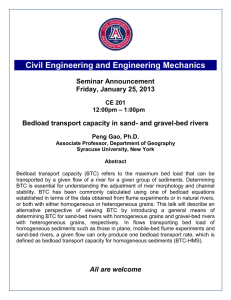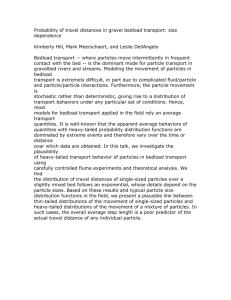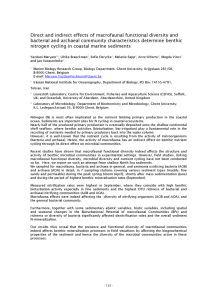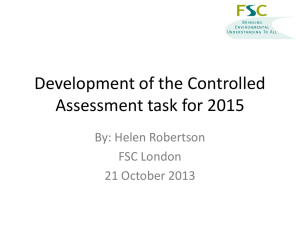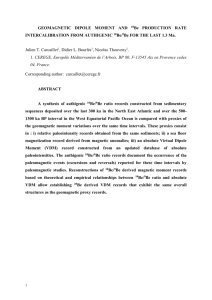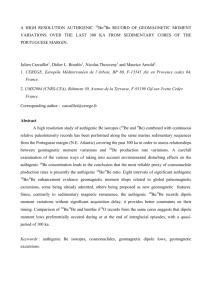jgrf20482-sup-0001-supinfo
advertisement
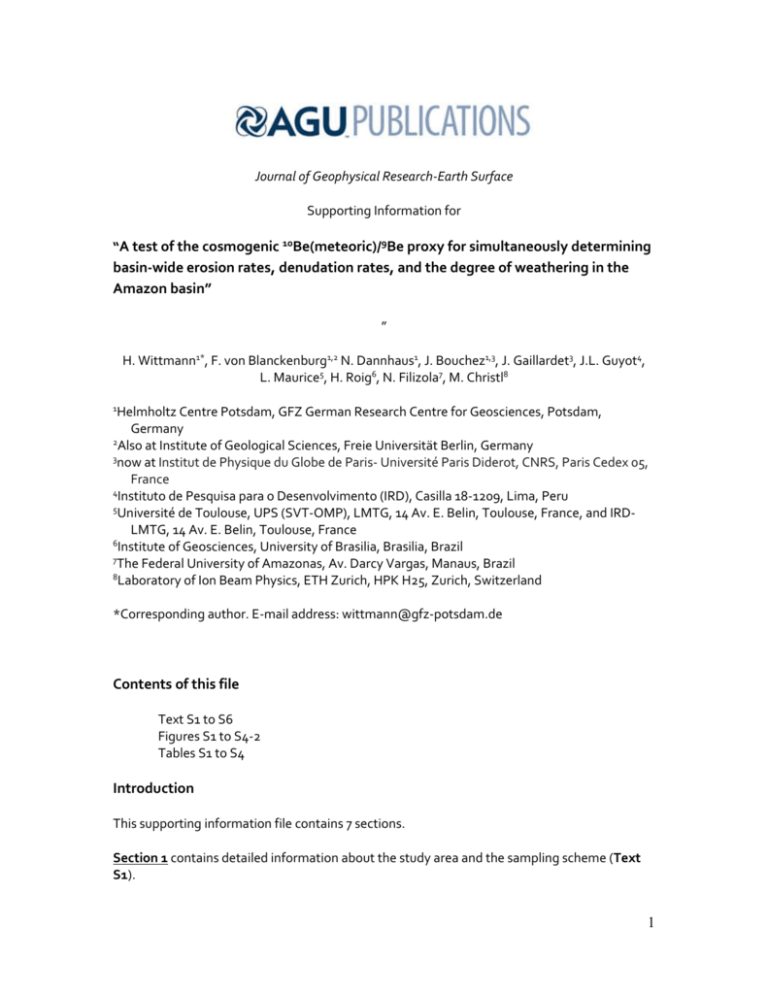
Journal of Geophysical Research-Earth Surface Supporting Information for “A test of the cosmogenic 10Be(meteoric)/9Be proxy for simultaneously determining basin-wide erosion rates, denudation rates, and the degree of weathering in the Amazon basin” ” H. Wittmann1*, F. von Blanckenburg1,2 N. Dannhaus1, J. Bouchez1,3, J. Gaillardet3, J.L. Guyot4, L. Maurice5, H. Roig6, N. Filizola7, M. Christl8 1 Helmholtz Centre Potsdam, GFZ German Research Centre for Geosciences, Potsdam, Germany 2 Also at Institute of Geological Sciences, Freie Universität Berlin, Germany 3 now at Institut de Physique du Globe de Paris- Université Paris Diderot, CNRS, Paris Cedex 05, France 4 Instituto de Pesquisa para o Desenvolvimento (IRD), Casilla 18-1209, Lima, Peru 5 Université de Toulouse, UPS (SVT-OMP), LMTG, 14 Av. E. Belin, Toulouse, France, and IRDLMTG, 14 Av. E. Belin, Toulouse, France 6 Institute of Geosciences, University of Brasilia, Brasilia, Brazil 7 The Federal University of Amazonas, Av. Darcy Vargas, Manaus, Brazil 8 Laboratory of Ion Beam Physics, ETH Zurich, HPK H25, Zurich, Switzerland *Corresponding author. E-mail address: wittmann@gfz-potsdam.de Contents of this file Text S1 to S6 Figures S1 to S4-2 Tables S1 to S4 Introduction This supporting information file contains 7 sections. Section 1 contains detailed information about the study area and the sampling scheme (Text S1). 1 Section 2 contains information about the analytical methods applied in this study, described in Text S2. Figure S1 is a schematic illustration of water sample treatment and Figure S2 shows the results, i.e. the obtained Be concentrations, of this water treatment. Section 3 contains information on a Be yield test carried out during ferric hydroxide precipitation, including Table S1 and Text S3 that explains the conducted experiments. Section 4 contains Table S2 that supplements qualitative information on the mineralogy of suspended sediment samples from depth profiles, obtained from XRD measurements. Section 5 contains information on the chemistry of the reactive phase, with explanatory Text S4 and Figure S3, expressed as a ratio of [Element X]reac to [Element X]total for major cations and Be. The data to construct this figure is contained in Tables S3-1 (bedload data) and S3-2 (data from suspended sediment depth profiles). Section 6 contains information on retentivity, with explanatory Text S5 and two figures. Figure S4-1 shows the correction of measured Kd values carried out in accordance with a published experimental dataset [You et al., 1989], and Figure S4-2 compares meteoric-derived denudation rates derived from two approaches, one is based on an equation ignoring a correction for retentivity, and one is based on an equation including the retentivity correction. These two approached agree well, i.e. we observe no retentivity issues. Section 7 reports the depositional flux, erosion rates, denudation rates, and weathering degrees calculated from published data Orinoco data [Brown et al., 1992] with an explanatory Text S6 and Table S4. Section 1- Detailed sampling information Text S1: a) bedload samples The terminology for samples as well as bedload sampling material are identical to those used in Wittmann et al. [2009] for Beni, Madre de Dios, Orthón, Mamoré, upper Madeira, and Grande samples. For other samples, we used the terminology and sampling material of Wittmann et al. [2011a]. Both studies used coarser sandy sediment for in situ-produced cosmogenic 10Be analysis, whereas this study uses mainly the 30-40 μm grain size fraction sieved from bedload. In addition to new bedload data, we use here averaged data from all grain size fractions (from <30 to 250 μm for samples Be 1, Cb 2, Br 7, and Obi) resulting in e.g. “Be1avg”, and the 30-40 μm fraction of samples Be 2 and Gr 19, all from Wittmann et al. [2012]. Samples characterizing the Andean geomorphic regime are bedload from the Solimões River (samples Pe 101,107, Peruvian and Ecuadorian Andes), and the Madeira River (samples Mad 19,20, Bolivian Andes), and its main tributaries Beni, Orthón, and Madre de Dios (samples Be 117, Or 16, and Md 15, respectively) as well as the Mamoré-Grande (samples Mar 18 and Gr 19, representing the lower and upper basin, respectively). To characterize the cratonic Shield regime, we sampled the Guaporé River (Cb 2: southern Brazilian Shield), the Aripuana (Cb 3: central Brazilian Shield), and the Teles Pires (samples Cb 5,6: northern Brazilian Shield). The 2 Guyana Shield located north of the central lowlands is drained by the Branco (samples Br 2 to 7), which is the main tributary of the Negro River (Ne 0.6). The Negro joins the Solimões at the city of Manaus, forming the Amazon River. Upstream of this confluence, we sampled the lower Solimõés at Manacapuru (sample Man 2.4) and downstream of the confluence, we sampled at Iracema (Ir 1.75). Between Iracema and Parintins (samples Par 0.9 to 2.2), the Amazon River is joined by the Madeira River (samples Mad 0.3 to 1.7). The lower Amazon was sampled at Óbidos (Obi). b) suspended sediment depth profiles Suspended sediment samples collected along depth profiles (termed “DSS”; see Table 3 for sampling depths) from the Andean zone have been analyzed for the Beni (Be-DSS, see Table 3 in main text), and for the Madre de Dios (Md-DSS). In the central Amazon lowlands, DSS samples were collected from the Madeira close to its confluence down to a maximum depth of 12 m, and from the main Amazon River at Óbidos down to a maximum depth of 55 m. These samples were collected in 2006 during the cruise when bedload and water samples (see below) also were collected. c) water samples Andean water samples have been collected in 2001 for the Beni (Be1-W) and the Madre de Dios (Md15-W). Central Amazon rivers were sampled for water in 2006 (when sampling for bedload and DSS samples was also conducted) at Iracema (Ir-W), Óbidos (Obi-W) and Madeira (Mad-W1 and W2) close to the confluence with the Amazon River. The Negro water sample was collected upstream of the Negro-Amazon confluence near Paricatuba. At Manacapuru on the lower Solimõés, we used data from a water sample from Brown et al. [1992]. Section S2: Analytical methods Text S2: a) bedload samples Samples were weighed (see Table 2 in main text), and the leaching procedure of Wittmann et al. [2012] was applied under clean lab conditions (see Wittmann et al. [2012] for full procedure). Wittmann et al. [2012] found that most [10Be]reac is located in the fractions of amorphous and crystalline oxides. These so-called am-ox and x-ox steps were combined to a “reactive” fraction for most samples before measurement. All leached fractions and, after dissolution, the silicate residual (containing [10Be]min and [9Be]min) were taken up in 3M HNO3. From these solutions (“OES split”), aliquots were taken for stable 9Be and other elemental analysis (section S5 for chemical characterization of extracted and residual phases), and the remaining solutions (“AMS split”) were spiked after splitting using ca. 200×10-6 g/g of our in-house “Phenakite” 9Be carrier. Spiked solutions were left to equilibrate for several hours, dried down again and taken up for column separation. The separation of 10Be was carried out according to the simplified separation scheme of von Blanckenburg et al. [1996; 2004] including anion- and cation column separation and alkaline precipitation. 10Be/9Be ratios were then measured at the ETH Zuerich accelerator mass spectrometer (AMS) [Kubik and Christl, 2010]. Blanks (mainly from carrier) yielded an average 10Be/9Be ratio of 2.51 ± 1.2×10-15 (n=11)). Blank amounts were subtracted and the standard deviation of their mean was propagated into all [10Be]. The calculated [10Be], 3 which were corrected for 10Be portioned to OES splits, are given in Table 2 in the main text with combined analytical and blank uncertainties. 9Be and major elements were measured using the OES split of the 3M HNO3 solutions by ICP-OES (Varian 720-ES, axial optics). We processed a second sample batch with newly weighed samples and measured [9Be]reac again to check the consistency of the procedure. Results of both batches are given in Table 2 in the main text, showing agreement mostly within uncertainty. In addition, we checked the accuracy of [9Be] by routinely measuring reference materials with similar matrix, comprising the granite “GA” (CRPG, published Be concentration is 3.6 ± 0.35×10-6 g/g Be (1σ std. dev.; Govindaraju [1995]) and the rhyolite “RGM-1” (USGS, published Be concentration is 2.4 ± 0.2 ×10-6 g/g Be (1σ std. dev.; Govindaraju [1994]). These reference materials were powdered, weighed, dissolved and diluted to a concentration of ca. 50 and 30×10-9 g/gsolid Be for the GA and the RGM-1, respectively, matching Be concentrations of samples in measurement conditions. We obtained 3.06 ± 0.21×10-6 g/g for the GA, and 2.16 ± 0.15×10-6 g/gsolid for the RGM-1 as mean long-term Be concentrations (n > 10 over a period of 2 years). Uncertainties given are the 1σ standard deviation calculated by propagating uncertainties from initial sample weight (5%), long-term OES repeatability (5%), and 1% balance uncertainty. Despite a systematic underestimation of Be concentrations by about 15%, results are very similar to the suggested range of the published values. b) suspended sediment samples from depth profiles (“DSS”) The same workflow as for bedload samples was applied to suspended sediment samples from depth profiles. These samples were treated in the new ultra-clean HELGES (Helmholtz Lab for the Geochemistry of the Earth´s Surface) facility at GFZ Potsdam and extracted am-ox and x-ox phases were measured separately (Table 3 in the main text). Measurements of OES splits involved the same method as for bedload samples (on the same instrument) and yielded similar long-term accuracy. AMS splits were treated like the bedload samples as described above. 10 Be/9Be ratios were measured at the Cologne University AMS [Dewald et al., 2013]. Blanks yielded an average 10Be/9Be ratio of only 6.3 ± 3.8×10-16 (n=4), whose amounts were subtracted and uncertainties propagated. In addition, we performed qualitative XRD measurements for bulk suspended sediments of the Madeira and Óbidos depth profiles (Table S2). c) water samples Water samples were separated into 2 aliquots, where one subsample was used for sector-field HR-ICP-MS (Thermo Scientific Element 2TM) 9Be analysis and another was used for 10Be analysis on an AMS (Fig. S1 and Table 4 in the main text). The AMS samples were weighed, spiked (blanks yielded an average 10Be/9Be ratio of 1.75 ± 0.07×10-15, n=2) and a FeCl3 solution was added to co-precipitate Be with ferric hydroxide (an approach we adapted from Jeandel [1993] and Frank et al. [2009] developed for ocean water). After centrifugation, the precipitate was redissolved and treated by anion and cation ion chromatography. Be yields were checked by running test solutions containing known Be concentrations; for all test runs resembling river water (Text S3), Be yields were higher than 90%, which we regarded as sufficient. The ICP-MS splits were pre-concentrated and taken up in 0.3 M HNO3 (Fig. S1), spiked with Indium solution as an internal reference using matrix-matched standards. We checked the accuracy of ICP-MS analyses by measuring the natural water reference material SRM 1640a (NIST, USA), certified value is 3.002 ± 0.068×10-12 g/g Be (1σ std. dev.). Over the course of 3 years, we measured a mean value of 3.12 ± 0.24×10-12 g/g Be (1σ std. dev.), yielding Be concentrations in good agreement with certified values. 4 Fig. S1: Schematic illustration of water sample treatment. Method for AMS splits involving coprecipitation by ferric hydroxide was adapted from Jeandel [1993] and Frank et al. [2009]. 5 Fig. S2: 10Be (at/gwater) and 9Be (×10-12 g/g) results of the water (“diss”) measurements. [10Be]diss of Amazon basin water samples are given by black circles (left axis) and [9Be]diss are given by white squares (right axis). The label “B” indicates data by Brown et al. [1992] in Amazon Rivers. Section S3: Be yield test Text S3: We have conducted tests of the precipitation method that are based on the methods developed by Jeandel [1993] originally developed for Nd isotope measurements in ocean water and the method developed by Frank et al. [2009] developed for meteoric 10Be measurements in ocean water. Based upon these tests, we determined that adding 1 mg Be to the 100 mL sample solution produced near-complete recovery of Be, and prepared samples accordingly. Be yields were consistently high, being on average 90% (Table S1). However, when adding organic matrix to test solutions (amount resembling a dissolved organic carbon concentration of 20 mg/L), recoveries were consistently lower, being ca. 60%. These yields are still sufficient for the determination of 10Be/9Be ratios (after spiking with 9Be); absolute 9Be concentrations are determined from direct Be measurements following pre-concentration by evaporation. Table S1- Result of precipitation tests using ferric hydroxide Matrix of solution Solution 1 Solution 2 Solution 3 Solution 4 Solution 5 (Elements in mL/L or ‰) No matrix added No matrix added Ca: 3; Mg: 5; Na: 2; Si: 10 Ca: 3; Mg: 5; Na: 2; Si: 10 Ca: 3; Mg: 5; Na: 2; Si: 5 pH ~10 ~9 9 9 8-9 FeCl 3 *6H 2 O Oxalic Acid (mg/L) 83 200 75 25 12.5 (mmol) - a Be added -6 b (× 10 g) 94.1 ± 0.9 189.8 ± 1.9 195.1 ± 2.0 197.2 ± 2.0 214.8 ± 2.1 Be in supernate (× 10 88.8 170.5 174.6 184.8 195.4 -6 ± ± ± ± ± c Be yield g) Be on filter (%) 94.4 89.8 89.5 93.7 91.0 4.4 8.5 8.7 9.2 9.8 d -6 (× 10 g) 2.6 3.2 7.8 19.7 39.7 e Average yield (no organic matrix) 91.7 ± 2.3 % Solution 6 Ca: 3; Mg: 7; Na: 2; Si: 5; K: 0.5 9 48 400 ± 12 361.9 ± 18.1 90.5 Solution 7 Ca: 3; Mg: <7; Na: 2; Si: 5; K: 0.5 9 48 0.80 400 ± 12 238.3 ± 11.9 59.6 Solution 8 No matrix added 9 48 0.84 400 ± 12 245.2 ± 12.3 61.3 Note that all solutions were equilibrated >1 day after pH increase via addition of NH4+ a Oxalic acid was added as substitue for organic C; concentration resembles natural waters (e.g. 20 mg/L DOC-dissolved organic carbon) b Uncertainty given contains a balance error of 1%; for tests using oxalic acid, Be was added volumetrically (pipette error of 3% is given) c 16.2 19.5 7.5 Gives Be amount in supernate after filtering; uncertainty given contains a 5% error of ICP-OES measurement d Filter was placed in 6M HCl for several hours to remove Be; solution was dried down and taken up in weak nitric acid for ICP-OES measurement e Uncertainty given contains propagated 1σ errors of balance and ICP-OES measurement: 6 Section S4: Qualitative mineralogical information on suspended sediment samples from depth profiles Table S2: Qualitative XRD results for DSS samples Original Sample sample code Quartz 2.Madeira depth profile (water depth in m) a Mad2-DSS-0m AM-06-38 ++ Mad2-DSS-10m AM-06-37 ++ Mad2-DSS-15m AM-06-36 ++ Óbidos depth profile (water depth in m) Obi-DSS-0m AM-06-59 ++ Obi-DSS-25m AM-06-57 ++ Obi-DSS-55m AM-06-55 ++ Illite Chlorite Kaolinite Albite Kfsp Smectite Halloysite Hematite + + + + + + - + + + +/- (microcl) +/- (microcl) + + + + + + + + + + - + + + + + + + + Presence and amount of minerals qualitatively indicating: ++ high, + medium, - low. a In absence of enough sample material, XRD was measured on a second Madeira profile sampled on the same day by Bouchez et al. [2010]. Section S5: The chemistry of the reactive phase Text S4: In order to characterize the extracted reactive phase, the exact mass of which is unknown, we calculate the ratio between reactive elemental concentrations ([Element X]reac) and total elemental concentrations ([Element X]total) for major cations such as Fe, Mn, Al, Ca, Na, Ti, K, and also Be (Fig. S3). For elemental concentrations of bedload and DSS samples see Tables S3-1 and S3-2. This ratio essentially indicates the fraction of bulk element X hosted in the reactive phase. As also observed by Wittmann et al. [2012], we observe that Fe, Mn, and Be are hosted mostly by the reactive phase relative to the total sample, followed (and in some cases exceeded) by Al and Ca (Fig. S3). The lowest contributions of the reactive phase are found for Na, Ti, and K. Be is therefore mostly present in the co-precipitated or the adsorbed form in MnFe-oxy(hydr-)oxides. We attribute high proportions of Al and Ca in the reactive phase to the presence of gibbsite and carbonates, respectively, and hypothesize that our extraction method only marginally decomposes feldspars and other non-reactive minerals [Wittmann et al., 2012]. We observe similar patterns within each of the following groups of samples, illustrated in Fig. S3: 1) the Beni and the Madre de Dios (panels A1,2), 2) Madeira and the Amazon (panels B1,2), 3) Brazilian Shield rivers (panel C). Within rivers draining the Guyana Shield (panel D), only the pattern of Br 7AVG [Wittmann et al., 2012] deviates strongly from those of Br 3 and Ne 0.6. This group also comprises the largest analyzed grain sizes of 90-250 μm, whereas in the other groups (panels A, B, C), mostly the 30-40 μm grain size was used. In general, suspended sediment depth profiles (panels A-2 and B-2, respectively) have more homogenous patterns than the corresponding bedload samples (panels A-1 and B-1). Qualitative X-ray diffraction for suspended sediment samples (Table S2) suggest that the mineralogy is much more heterogeneous than that for bedload samples, as the former also contain illite, kaolinite, and smectite in addition to quartz, chlorite, albite, and K-feldspar, the latter presented in Wittmann et al. [2012]. However, bedload patterns show similar trends as depth profiles, with only Na, Ti, and K even more marginally hosted by the reactive phase of bedload than in suspended 7 sediments. This implies that the contribution of the reactive phase relative to the bulk elemental budget does not depend strongly on grain size for these elements. Fig. S3. Composition of the reactive phase as fractions (%) of element concentrations in the reactive phase ([Element X]reac) relative to total element concentration ([Element X]total, summed from [Element X]reac + [Element X]min), all calculated relative to initial sample solid mass). 100% means that the element is hosted only in the reactive (“reac”) phase, while 0% indicate that the element is hosted only in the mineral (“min”) residual phase. Panels A.1 and A.2 show results for Andean Rivers analyzed for bedload (A.1) and suspended sediments from depth profiles (A.2), respectively. Panels B.1 and B.2 are central Amazon bedload (B.1) and suspended sediment depth profile (B.2) samples, respectively. Panels C and D give bedload data for Brazilian and Guyana Shield Rivers, respectively. Patterns of Be1AVG (Panel A-1), ObiAVG (Panel B-1), CB2AVG (Panel C) and Br7AVG (Panel D) are from Wittmann et al. [2012]. 8 Table S3-1: Major elemental data for summed leached phases (X-Ox + Am-Ox) and silicate residue (Min) for bedload samples Summed leached phases (Am-Ox + X-Ox) Sample b Be 1 AVG Be 2-Rep1 Be 2-Rep2 Be 3 Be 4 Be 8 Be 10 Be 12 MD 15 OR 16 Be 17 Mar 18 Mad 19 Mad 20 GR 19 Pe 101 Pe 107 Man 2.4 Ir 1.75 Par 0.9 Par 1.2 Par 1.6 Par 2.2 Obi AVG Mad 0.3 Mad 0.5 Mad 1.8 b Cb 2 AVG Cb 3 Cb 5 Cb 6 Br 2 b Grain size fraction (µm) Al all analyzed 30-40 30-40 30-40 30-40 30-40 30-40 30-40 30-40 30-40 30-40 30-40 30-40 30-40 30-40 30-40 30-40 30-40 30-40 30-40 30-62 30-40 30-40 5510 5610 5370 5230 6140 4520 4380 4810 6800 2900 4690 4250 5670 4150 4470 6320 3120 8470 5570 7390 5330 6160 9990 25500 23800 19400 22000 29700 22000 19800 21700 20100 8210 19500 12200 23900 14600 23800 21000 8150 31500 19900 22800 16700 21300 28600 510 540 520 640 610 370 450 520 590 280 460 470 590 440 590 610 320 570 430 470 440 480 620 2340 1650 1700 1330 1860 780 1630 1310 1800 880 1770 1840 1430 1300 3210 6340 7780 3760 2150 1700 2210 2350 2920 all analyzed 30-40 30-62 30-40 5430 8580 3620 7670 10300 27200 19200 41000 420 520 370 450 all analyzed 30-40 30-62 30-62 90-125 3680 5590 2075 3700 140 6508 11600 2200 7500 420 Fe K Ca Na a Silicate residue (Min) Mn Ti Al Fe Ti Mg 78 60 92 67 69 37 67 54 100 54 82 160 59 64 68 230 93 450 160 130 170 240 220 320 280 230 220 280 170 190 200 190 650 180 160 220 170 440 210 130 260 510 190 170 180 290 39 38 19 43 59 42 48 55 150 30 110 35 120 70 12 330 77 1300 190 530 290 540 460 18100 10400 8220 320 4160 18600 4900 10250 250 6110 200 7005 430 39 3650 460 34100 10800 7570 540 6140 40100 23000 7750 6500 8230 190 9890 1460 620 13000 3120 33600 39000 28000 6900 6380 9410 4410 790 6700 7900 770 94 19000 8050 2400 1550 32800 2370 39800 15900 500 31400 7120 11600 9150 3020 12 9240 7100 580 14300 400 590 11400 480 10500 2080 21 3070 48400 28600 36900 32100 7600 14600 14700 620 9200 7030 7700 10040 12100 640 11600 3950 1250 1310 970 960 130 75 68 47 180 330 160 830 150 75 260 110 18250 34200 24800 5430 13800 63500 8900 12700 5330 3300 1450 3670 2410 4710 4640 110 250 1550 2500 9040 30200 1070 2250 2290 220 130 140 200 130 380 300 110 350 10 39 14 14 21 2 75 100 16 540 5 50 43 63 79 30 27000 28600 21100 23800 5800 9100 3600 9320 4380 6550 7560 5710 840 140 290 1130 1000 450 640 1420 210 220 210 360 5890 11500 5750 9940 720 550 480 780 630 430 2700 120 79 14 330 55 -6 (all concentrations in ×10 g/g) Br 3 125-250 74 130 60 4 1 2 7 Br 4 125-250 130 200 130 5 2 3 10 K Ca Na Mn (all concentrations in ×10 -6 g/g) b Br 7 AVG all analyzed 2310 560 60 60 7 4 60 2360 4100 3300 90 52 220 4500 50 Ne 0.6 125-250 85 160 160 3 1 1 7 1780 910 16300 32 110 52 990 20 Note that repeatability of ICP-OES measurements is within an uncertainty of 5%, except for K and Na, where for external comparison an uncertainty of 10% should be propagated. a Mg conc. of summed leach are not given as they might be biased due to using MgCl 2 in the preceeding step. Si conc. were not determined due to decomposition with HF. b Presented concentrations denote averages, please see Wittmann et al. [2012] for details. Table S3-2: Major elemental data for summed leached phases (X-Ox + Am-Ox) and silicate residue (Min) for DSS samples Original sample a Summed leached phases (Am-Ox + X-Ox) and silicate residue (Min) Grain size fraction (µm) Al Fe Am-Ox + X-Ox Am-Ox + X-Ox 18600 15700 52000 43000 750 670 2830 2190 400 270 630 395 195 200 Am-Ox + X-Ox Am-Ox + X-Ox 29000 17100 55300 44500 1050 580 3970 2840 335 190 695 615 350 290 Min Min 99000 53000 7900 4400 9370 5440 340 330 5800 3900 45 43 5010 3500 3640 1810 Min Min 83000 63000 10250 10200 6620 6130 6130 9500 4800 5350 120 173 6100 5200 4050 3740 Am-Ox + X-Ox Am-Ox + X-Ox Am-Ox + X-Ox 16200 13200 10500 43000 35000 28000 940 840 670 880 820 710 200 170 120 390 420 406 175 300 140 Am-Ox + X-Ox Am-Ox + X-Ox Am-Ox + X-Ox Am-Ox + X-Ox Am-Ox + X-Ox 18300 29000 16000 21000 11000 38200 52500 34000 39000 25000 930 1010 870 730 540 1180 4850 2110 4400 1040 325 530 310 390 210 680 735 640 665 440 345 380 273 274 160 Mad-DSS-0m Am-06-35 susp. sedim. Mad-DSS-6m Am-06-34 susp. sedim. Mad-DSS-12m Am-06-33 susp. sedim. Óbidos depth profile (water depth in m) Min Min Min 91000 67000 58400 10400 8100 7500 27000 19000 17500 1060 1150 1230 6200 5680 5740 72 72 76 5620 4970 4650 4060 3005 2650 Obi-DSS-0m Obi-DSS-10m Obi-DSS-25m Obi-DSS-40m Obi-DSS-55m Min Min Min Min Min 69000 82000 64000 86000 54100 9890 10500 9500 11700 9370 16300 7020 17000 7600 16000 1840 4970 2290 4905 3150 5410 5870 6480 6540 7200 65 92 84 100 110 4200 4740 4300 4660 3800 3500 4300 3345 4540 3100 code Beni depth profile (water depth in m) Be-DSS-1.5m Am-07-03 susp. sedim. Be-DSS-4.5m Am-07-01 susp. sedim. Madre de Dios depth profile (water depth in m) Md-DSS-0m Am-07-14 susp. sedim. Md-DSS-7m Am-07-11 susp. sedim. Beni depth profile (water depth in m) Be-DSS-1.5m Am-07-03 susp. sedim. Be-DSS-4.5m Am-07-01 susp. sedim. Madre de Dios depth profile (water depth in m) Md-DSS-0m Am-07-14 susp. sedim. Md-DSS-7m Am-07-11 susp. sedim. Madeira depth profile (water depth in m) Mad-DSS-0m Am-06-35 susp. sedim. Mad-DSS-6m Am-06-34 susp. sedim. Mad-DSS-12m Am-06-33 susp. sedim. Óbidos depth profile (water depth in m) Obi-DSS-0m Am-06-59 susp. sedim. Obi-DSS-10m Am-06-58 susp. sedim. Obi-DSS-25m Am-06-57 susp. sedim. Obi-DSS-40m Am-06-56 susp. sedim. Obi-DSS-55m Am-06-55 susp. sedim. Madeira depth profile (water depth in m) Am-06-59 Am-06-58 Am-06-57 Am-06-56 Am-06-55 susp. sedim. susp. sedim. susp. sedim. susp. sedim. susp. sedim. K Ca Na Mn (all concentrations in ×10 -6 g/g) a Samples are splits from those analyzed by Bouchez et al. [2010]. b Mg conc. of summed leach are not given as they might be biased due to using MgCl 2 in the preceeding extraction. Si conc. were not determined due to decomposition with HF. Ti Mg b Fraction Sample 9 Section S6: Retentivity correction Text S5. Correction of Kd values and comparison between different meteoric-derived denudation rates You et al. [1989] derived Be partition coefficients from experiments using 7Be across the full pH range (i.e. chemical equilibrium most likely attained). From this dataset, we calculated a linear regression (Fig. S4-1) and used this fit to correct our data. The good agreement between D_METmin/reac-full and the simplified D_METmin/reac’ observed in Fig. S4-2 indicates that retentivity is high throughout all geomorphic zones of the Amazon basin and that the bias introduced by sorting effects on the calculation of erosion and denudation rates is much larger. Fig. S4-1. Correction of measured Kd values (mL/g) (in grey, calculated from measured [10Be]diss and [10Be]reac) versus average pH values according to linear fit for the dataset of You et al. ([1989]; dataset itself not shown). Filled grey symbols: bedload samples, grey with red outline symbols: depth-integrated DSS samples. Green symbols represent the same dataset but corrected according to linear (green) fit. Note that the same pH values are used for bedload and DSS data. Resulting corrected Kd values (Table 5 in the main text) are the same for DSS as for bedload data and only the relative difference between corrected and initial Kd values is different between the datasets. 10 Fig. S4-2. Denudation rates D_METmin/reac-full (mm/yr; Eq. 13 from main text) and D_METmin/reac’ (using Eq. 15 from main text). Section S7: Erosion and denudation rates for the Orinoco basin Text S6: By using the mass balance approach of von Blanckenburg et al. [2012], we calculated erosion rates and denudation rates from the data provided by Brown et al. [1992] for the Negro, Orinoco, Apure, and La Tigra basins (Table S4). A D_METmin/reac-full (Eq. 13 in main text) for the Orinoco of 0.03 mm/yr was calculated by using [9Be]min data from Negro and Apure samples as an approximation. This denudation rate compares to an in situ 10Be-derived denudation rate D_InSitu of 0.06 mm/yr for the Orinoco. For the Negro, a D_InSitu is ca. 0.04 mm/yr (Wittmann et al. [2011]) We find an overall good agreement between E[10Be]full and D_METmin/reac-full (Table S4). This good agreement is most likely due to Brown et al. [1992] having analyzed suspended sediments. The [10Be]reac of these suspended sediments may best represent erosion processes in the basin. 11 References Brown, E. T., J. M. Edmond, G. M. Raisbeck, D. Bourlès, F. Yiou, and C. I. Measures (1992), Beryllium isotope geochemistry in tropical river basins, Geochimica Et Cosmochimica Acta, 56, 1607-1624. Bouchez, J., F. Métivier, M. Lupker, L. Maurice, M. Perez, J. Gaillardet, and C. France-Lanord (2010), Prediction of depth-integrated fluxes of suspended sediment in the Amazon River: particle aggregation as a complicating factor, Hydrological Processes, 25(5), 778-794, doi:10.1002/hyp.7868. Dewald, A., et al. (2013), CologneAMS, a dedicated center for accelerator mass spectrometry in Germany, Nuclear Instruments and Methods in Physics Research Section B: Beam Interactions with Materials and Atoms, 294(0), 18-23, http://dx.doi.org/10.1016/j.nimb.2012.04.030. Frank, M., D. Porcelli, P. Andersson, M. Baskaran, G. Björk, P. W. Kubik, B. Hattendorf, and D. Guenther (2009), The dissolved Beryllium isotope composition of the Arctic Ocean, Geochimica Et Cosmochimica Acta, 73(20), 6114-6133, http://dx.doi.org/10.1016/ j.gca.2009.07.010. Govindaraju, K. (1994), 1994 Compilation of working values and descriptions for 383 geostandards, Geostandards Newsletter, 18, 1-158. Govindaraju, K. (1995), 1995 working values with confidence limits for twenty-six CRPG, ANRT and IWG-GIT geostandards, Geostandards Newsletter, 19 (Special Issue), 1-32. Heikkilä, U., J. Beer, J. A. Abreu, and F. Steinhilber (2013a), On the Atmospheric Transport and Deposition of the Cosmogenic Radionuclides (10Be): A Review, Space Science Reviews, 176(1-4), 321-332, doi:10.1007/s11214-011-9838-0. Heikkilä, U., S. J. Phipps, and A. M. Smith (2013b), Be-10 in late deglacial climate simulated by ECHAM5-HAM - Part 1: Climatological influences on Be-10 deposition, Climate of the Past, 9(6), 2641-2649, doi:10.5194/cp-9-2641-2013. Jeandel, C. (1993), Concentration and isotopic composition of Nd in the South Atlantic Ocean, Earth and Planetary Science Letters, 117(3-4), 581-591, http://dx.doi.org/10.1016/0012821X(93)90104-H. Kubik, P. W., and M. Christl (2010), 10Be and 26Al measurements at the Zurich 6 MV Tandem AMS facility, Nuclear Instruments and Methods in Physics Research Section B- Beam Interactions with Materials and Atoms, 268, 880-883, doi: 10.1016/j.nimb.2009.10.054. von Blanckenburg, F., N. Belshaw, and R. K. O´Nions (1996), Separation of Be-9 and cosmogenic Be-10 from environmental materials and SIMS isotope dilution analysis, Chemical Geology, 129, 93-99. 12 von Blanckenburg, F., T. Hewawasam, and P. W. Kubik (2004), Cosmogenic nuclide evidence for low weathering and denudation in the wet, tropical highlands of Sri Lanka, Journal of Geophysical Research-Earth Surface, 109(F3), doi:F0300810.1029/2003jf000049. Wittmann, H., F. von Blanckenburg, L. Maurice, J. L. Guyot, N. Filizola, and P. W. Kubik (2011a), Sediment production and delivery in the Amazon River basin quantified by in situproduced cosmogenic nuclides and recent river loads, Geological Society of America Bulletin, 123(5-6), 934-950, doi:10.1130/B30317.1. Wittmann, H., F. von Blanckenburg, J. Bouchez, N. Dannhaus, R. Naumann, M. Christl, and J. Gaillardet (2012), The dependence of meteoric 10Be concentrations on particle size in Amazon River bed sediment and the extraction of reactive 10Be/9Be ratios, Chemical Geology, 318-319(0), 126-138, doi:10.1016/j.chemgeo.2012.04.031. 13
